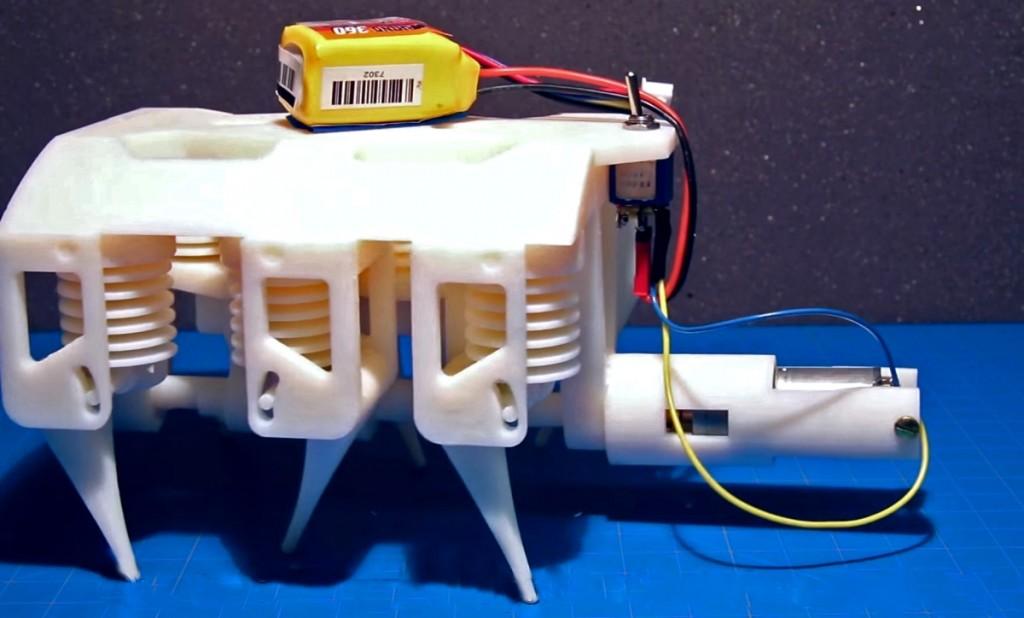Printable Hydraulics: MIT Researchers Predict One Day Customized Robots Will Walk Right Out of Your 3D Printer
 The use of the 3D printer today is something that most anyone can master. We’ve boiled the technology down so that it can be integrated into elementary, middle, and high schools—as well as community colleges. You can shop and order a 3D printer online or go to Sam’s Club and buy one, or even see one in action, along with 3D scanning, during pilot programs like one we reported on recently for iMcustom. You can buy 3D printer kits at virtually a tenth of the price and go the DIY route, and even make improvements with open-source models. The point is that 3D printing has hit the mainstream—and the mainstream is embracing it more than enthusiastically.
The use of the 3D printer today is something that most anyone can master. We’ve boiled the technology down so that it can be integrated into elementary, middle, and high schools—as well as community colleges. You can shop and order a 3D printer online or go to Sam’s Club and buy one, or even see one in action, along with 3D scanning, during pilot programs like one we reported on recently for iMcustom. You can buy 3D printer kits at virtually a tenth of the price and go the DIY route, and even make improvements with open-source models. The point is that 3D printing has hit the mainstream—and the mainstream is embracing it more than enthusiastically.
But what happens when you put together 3D printers and the brilliant minds at MIT? We end up with innovation that just makes you shake your head in wonder. Straying ahead from the current hoopla regarding bioprinting and sending 3D printers into space, scientists from MIT’s Computer Science and Artificial Intelligence Laboratory (CSAIL) have learned how to print with both solids and liquids at the same time, which should lend itself strongly to the robotics realm. They have released their findings in ‘Printable Hydraulics: A Method for Fabricating Robots by 3D Co-Printing Solids and Liquids,’ by Robert MacCurdy, Robert Katzschmann, Youbin Kim, and Daniela Rus, a paper just published on Cornell University Library’s open source database.
 The paper outlines how using commercial 3D printers that have been specifically adapted for their research, they have created a new technique which they refer to as ‘printable hydraulics.’ In this process, they are able to take a photopolymer 3D printer and enhance it with the capability for liquids to be printed simultaneously with solids—and taking it one major step further—allowing for the liquid to be stored within the solid as it is being printed.
The paper outlines how using commercial 3D printers that have been specifically adapted for their research, they have created a new technique which they refer to as ‘printable hydraulics.’ In this process, they are able to take a photopolymer 3D printer and enhance it with the capability for liquids to be printed simultaneously with solids—and taking it one major step further—allowing for the liquid to be stored within the solid as it is being printed.
“When the parts are being printed, they’re being printed layer by layer, in very thin layers. At those kinds of scales, at the height of the layers, the size of the droplets we deposit allows materials that are solids and liquids to sit next to each other on that layer, because of the surface tension of these droplets,” said CSAIL post-doctoral associate Robert MacCurdy in a recent interview.
The potential here is that one day machines will be able to completely produce robots, ready to go. So far they’ve produced a rudimentary prototype, but it displays the concept very well in that the robot comes out of the 3D printer, made in just one step, needing only a battery and motor.
This probably was not a problem most of us having been worrying how to solve, but the concept is certainly fascinating in terms of being able to churn out robots—in one step. It took the researchers a year to refine their new method.“We have a 3D printer that can lay out either solids or liquids, and then we have an algorithm that decides when the printer should put down a water droplet or solid droplet. This allows us to create objects that were not possible to create before,” said CSAIL director Daniela Rus.”This allows us to 3D print hydraulic mechanisms and incorporate them into the robot. The reason the liquids stay liquid is because they are enclosed in a mechanism of pipes.”
“Building robots has historically been a time consuming process. Constrained by available fabrication techniques, conventional robotic design practice dictates that engineers sequentially assemble robots from many discrete parts, with long concomitant assembly times,” state the researchers in their paper. “Mass production achieves efficiency gains through optimizing each assembly step, but optimization requires that the design be fixed; even small changes become difficult and costly.
The key in this new method is that things are happening on more than one level, simultaneously. The materials that are to be solid are cured by the UV light, but the droplets remain in liquid form. This allows the scientists to embed hydraulic channels for the robotic parts—and in being able to do that, it’s an all-in-one streamlined process without the need to add or take anything away.
“The printer used in this work, a Stratasys Objet260 Connex, uses an inkjet head to deposit three different photopolymers simultaneously and achieves finished-part resolutions better than 100µm,” state the researchers in their paper. “The Objet260 uses eight print-heads with linear arrays of nozzles to deposit resins onto the build surface. These resins rapidly cure when exposed to the high-intensity UV light source mounted on the print head. Three-dimensional models are broken up into thin slices, and printed from the bottom-up, layer by layer.”
The ultimate idea is that one day when this idea hits the mainstream for us all you might be able to print out your own robot at home. Scientists literally foresee the robot being able to ‘walk itself out of the printer.’ This is all a result of your being able to tell the printer what you want in a design, for it to integrate the programming, and then give you a machine that will clean your floor, pick things up, always showing up when you need him, never late—and offering the greatest of benefits: no whining! How soon can we sign up?
Check out the video below which shows a prototype the researchers have created. All that’s involved is a motor and a battery, and it’s off and running! It can even be controlled by a smartphone. How do you think this will impact the future? Discuss in the 3D Printing LIquids & Solids forum over at 3DPB.com.
[Source: International Business Times]Subscribe to Our Email Newsletter
Stay up-to-date on all the latest news from the 3D printing industry and receive information and offers from third party vendors.
Print Services
Upload your 3D Models and get them printed quickly and efficiently.
You May Also Like
Reinventing Reindustrialization: Why NAVWAR Project Manager Spencer Koroly Invented a Made-in-America 3D Printer
It has become virtually impossible to regularly follow additive manufacturing (AM) industry news and not stumble across the term “defense industrial base” (DIB), a concept encompassing all the many diverse...
Inside The Barnes Global Advisors’ Vision for a Stronger AM Ecosystem
As additive manufacturing (AM) continues to revolutionize the industrial landscape, Pittsburgh-based consultancy The Barnes Global Advisors (TBGA) is helping shape what that future looks like. As the largest independent AM...
Ruggedized: How USMC Innovation Officer Matt Pine Navigates 3D Printing in the Military
Disclaimer: Matt Pine’s views are not the views of the Department of Defense nor the U.S. Marine Corps Throughout this decade thus far, the military’s adoption of additive manufacturing (AM)...
U.S. Congress Calls Out 3D Printing in Proposal for Commercial Reserve Manufacturing Network
Last week, the U.S. House of Representatives’ Appropriations Committee moved the FY 2026 defense bill forward to the House floor. Included in the legislation is a $131 million proposal for...


































